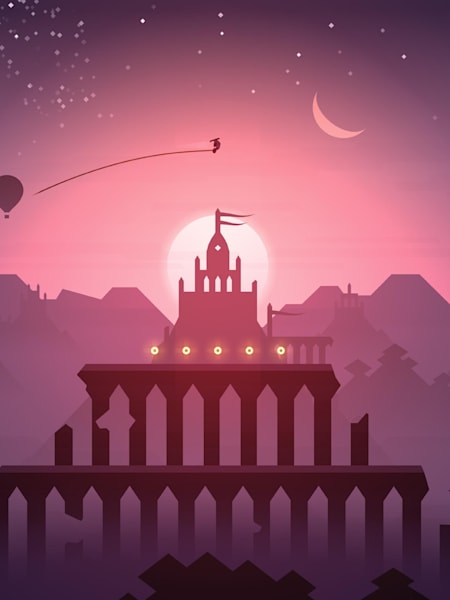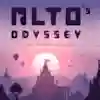Gaming
Endless runners are a dime a dozen on mobile, but Snowman’s snowboarding title Alto’s Adventure managed to stand out from the crowd with its simple-yet-addictive gameplay, serene soundtrack and captivating visuals. Three years on from its launch, Team Alto (the collaboration between Snowman and Harry Nesbitt) is back with its successor, Alto’s Odyssey, that trades the snow-drenched vistas for an endless desert with plenty of new tricks and obstacles for you to tackle.
Ahead of the game’s launch on iOS this week, we caught up with the team behind one of mobile’s most anticipated games to find out what went on behind the scenes of development, whether we’ll see Snowman tackle the Nintendo Switch and tips on how to make the most of your venture into the desert.
Watch the trailer for Alto's Odyssey below:
Tell us what’s been going on with Alto’s Odyssey as you guys are gearing up for launch?
Ryan Cash, founder of Snowman: As we close in on release, a lot of our focus has been on making sure the world of Alto’s Odyssey feels as magical as possible for players. We’ve been trying as much as possible to squeeze in surprises and flourishes with weather, lighting, wildlife and other areas of the game that will bring joy to our players. Of course, I’d be lying if I said we also weren’t squashing a few last-minute bugs and working like mad to get the word out about the game! Typical pre-launch stuff, in many ways.
How have the past few months leading up to release been?
Eli Cymet, lead producer on Alto’s Odyssey: I think a blur would be putting it lightly. I tweeted just after our launch trailer came out that there’s this feeling you get when you’re making something and haven’t shared it with the world yet. This sense, at times, that it doesn’t really exist. It might sound silly, but it’s definitely a palpable feeling and it’s been surreal over the last few months.
Coming to grips with the fact that this thing we’ve been making and thinking about and obsessing over is actually going to be real and in the hands of players soon. In short, I guess I’d say: excited, nervous, anxious, focused… all of the above?
Alto’s Adventure came out back in 2015; how long have you guys been working on Odyssey?
RC: From my personal perspective, I had always wanted Alto’s Adventure to be the beginning of a story for our cast of characters that we could tell over many years. As part of this, I’ve had my own ideas about where we might take these characters next for a long time.
With that said, while the game will be releasing just after the three-year anniversary of Adventure’s release, we’ve only been working on the game in a core development capacity for a year and a half.
What makes it a sequel and sets it part from Adventure?
Harry Nesbitt, lead artist and programmer: Something I think I’d want to say is that it’s not a sequel – none of the ways we’ve thought about making it are as a sequel. We’re not seeking to one-up the first game. We’re trying to create another game set in the same world that taps into a different set of emotions.
RC: That’s definitely a cornerstone of how we approached Alto’s Odyssey. We want both games to be able to sit alongside one another for many years to come. Players should be able to discover either title as their first Alto’s game and experience the qualities that make Alto what it is: fluid movement, a sense of flow and the feeling of escaping to a fantastical place far from home.
EC: With that said, I think the feelings we’re exploring this time around and the places they led us in design make this an experience that will absolutely feel fresh and exciting for returning players. The presence of biomes – these diverse natural spaces that transition seamlessly into one another – makes the game much vaster in scope than Alto’s Adventure. They bring with them a host of new core mechanics like wallriding, moving grind rails, multi-tiered grinds that snap and sway, tornados and rushing water.
All of these features lend themselves to a greater sense of exhilaration, and allow players to get up and into the air to pull off big combos. We’ve gone to great lengths to make sure none of them add any new control inputs though, making the fundamental play experience as accessible as ever.
The first game really captured that kind of tranquility from the mountains and the soundtrack was equally as soothing, even while you’re chasing points – did you aim for more of the same this time, or did you want to create something a little more different?
EC: As with the first game, it was very important to capture a specific feeling. We spent a lot of time talking together and thinking about what emotions we might want to stir in players before committing to development. We didn’t want to treat another Alto game like a foregone conclusion because of the success of the first title.
Things really clicked when we reflected as a group on how much our lives had changed since the release of Alto’s Adventure. The team had grown, some of us had moved away from the homes we knew to live in other places and we'd all experienced big personal upheaval in different ways. What we arrived at was a desire to capture the feeling of going outside your comfort zone, exploring the unfamiliar and accepting that the concept of ‘home’ is related to the people close to you, not any one place. In many ways, this is what led us to the grandeur of Alto’s Odyssey’s setting.
Do you think that with Adventure nailed, you had a great base to start on? How many iterations did you go through before you ended up on the Odyssey idea?
HN: A lot of things about the first game happened quite naturally, or came about as a solution to a particular problem. So by the time you're finished, you’ve got these rules, and you don’t know if they can be applied to other things. The art style for Adventure came about over a bunch of iterations; it didn’t spring into being with a full understanding of what works and what doesn’t.
It had to be chipped away at slowly. So when you try to then take that ruleset and apply it to new things, there’s no guarantee that it’s going to work. The first game was a sort of lightning in a bottle scenario and now you’re trying to recapture that all over again. It’s definitely a challenge.
We’ve gone from the snowy mountains to the desert; what made you want to choose sand dunes for the sequel?
RC: It was important for us that any setting or mechanics for the game be secondary to how the game would feel to players. Speaking only for me personally, I’ve been fascinated with desert vistas and spaces since well before Alto’s Adventure launched, and was already ideating on mechanics that could be fun in a desert setting.
We were very fortunate that some of the things happening in our own lives and the emotions we wanted to explore fit a setting that was so much the other side of the coin from Adventure’s snowy, cosy mountain.
Did you guys mess around with the controls at all? Did you try and give Alto any new abilities?
RC: Once we set down to playing around in the new desert space, we spent a month or so in what we called an ‘Alto Jam’, experimenting with new mechanics and features. Many – like the idea of Alto having a grappling hook – ended up on the cutting room floor, but we were drawn to those which reinforced this sense of of exploration: the ability to ride rock walls, multiple natural biomes to discover and brand-new wildlife to interact with. Ultimately, what we established for ourselves was a sort of golden rule around exploring as many new mechanics as made sense without adding any new required controls.
What are some of the weirdest bugs you guys came across while developing the game?
Joe Grainger, designer and programmer: We definitely had some funny and notable bugs come up making Alto's Odyssey. There was a time when switching characters on the title screen would result in any new character you chose becoming badly deformed, with some even losing their full lower halves.
Our wildlife also took a long time to tame. For much of the early part of development, the fish players will see swimming in water pools would aggressively float around in the sky. Meanwhile, the lemurs that dot the landscape would often go fully prone without warning and move along the ground rigidly as if they were frozen. In reality, a lot of development is spent wrangling this chaos and taming it into something beautiful.
What will veteran Adventure players find new with Odyssey?
RC: Something we spent a lot of time trying to balance during development was the introduction of new features with an overall design and approach that felt timeless. There are a host of new core mechanics like wallriding, tornados, breakable grind rails and rushing water that give people new things to see and do every run. More than that, though, everything combines to offer an overall higher skill ceiling without diminishing accessibility.
Some members of our team enjoy seeing the scenery and taking photos more, whereas I love to challenge myself (and others on the team!) to get the highest score possible. I still compulsively find myself coming back to play and discovering new ways to express myself with combos and tricks. Besides that, there’s a lot going in the game’s foreground, background and wildlife that we don’t want to spoil! I think players will be very surprised at what they discover.
What can you tell us about an Android launch for the game?
RC: We love and haven’t forgotten about our Android players! We aren’t committing to a release date at the moment, but we’re hoping to get an Android version out in the months ahead.
What about consoles at all? Has the success of the Switch given you any ideas?
EC: Something we talk a lot about as a team is that many of us don’t come from traditional gaming backgrounds. We wear this on our sleeves because we think that play is such a fundamental human impulse and believe there are ways to connect with people that don’t require traditional 'gaming literacy'.
In this sense, we’ve always been massive fans of Nintendo both as players and developers for the way they have – and continue to – embrace this idea of play being for everyone. I see Nintendo Switch as a significant innovation for this exact reason. It doesn’t feel preoccupied with the place it occupies as either a console or mobile device and delivers delightful experiences at home and on the go. It really is helping people ‘unlearn’ this idea of mobile experiences as inherently inferior and, in that regard, it’s a really exciting system.
What’s your hottest tip for Odyssey players?
RC: One of the most overlooked and simple tips I always like to give is: save up for the wingsuit as soon as possible! It’s pricey, but it’s absolutely worth it and massively opens up the game in terms of combo possibilities, the ability to get out of tricky situations, and the opportunity to set long distance records.
We have a few other really great workshop items this time around that I’m excited for players to experience, but the wingsuit is a classic that I can’t recommend highly enough. Oh – and try to look at rocks in a positive light. Once you get the hang of it, you can use them to your advantage.
Alto’s Odyssey launches February 22 on iOS and Apple TV.











